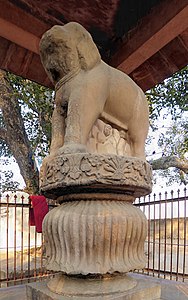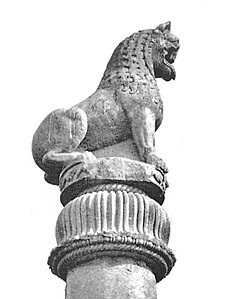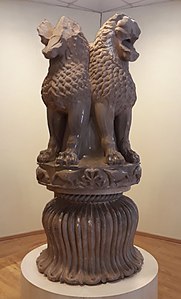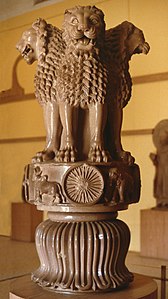Pillars of Ashoka
| Pillars of Ashoka | |
|---|---|
Rummindei Known locations of the Pillars of Ashoka[1] |
The pillars of Ashoka are a series of
The pillars of Ashoka are among the earliest known stone sculptural remains from India. Only another pillar fragment, the
All the pillars of Ashoka were built at Buddhist monasteries, many important sites from the life of the
Ashoka and Buddhism

Ashoka ascended to the throne in 269 BC inheriting the
Construction
The traditional idea that all were originally quarried at Chunar, just south of Varanasi and taken to their sites, before or after carving, "can no longer be confidently asserted",[19] and instead it seems that the columns were carved in two types of stone. Some were of the spotted red and white sandstone from the region of Mathura, the others of buff-colored fine grained hard sandstone usually with small black spots quarried in the Chunar near Varanasi. The uniformity of style in the pillar capitals suggests that they were all sculpted by craftsmen from the same region. It would therefore seem that stone was transported from Mathura and Chunar to the various sites where the pillars have been found, and there was cut and carved by craftsmen.[20]
The pillars have four component parts in two pieces: the three sections of the capitals are made in a single piece, often of a different stone to that of the monolithic shaft to which they are attached by a large metal dowel. The shafts are always plain and smooth, circular in cross-section, slightly tapering upwards and always chiselled out of a single piece of stone. There is no distinct base at the bottom of the shaft. The lower parts of the capitals have the shape and appearance of a gently arched bell formed of lotus petals. The abaci are of two types: square and plain and circular and decorated and these are of different proportions. The crowning animals are masterpieces of Mauryan art, shown either seated or standing, always in the round and chiselled as a single piece with the abaci.[21][22] Presumably all or most of the other columns that now lack them once had capitals and animals. They are also used to commemorate the events of the Buddha's life.
Currently seven animal sculptures from Ashoka pillars survive.[5][24] These form "the first important group of Indian stone sculpture", though it is thought they derive from an existing tradition of wooden columns topped by animal sculptures in copper, none of which have survived. It is also possible that some of the stone pillars predate Ashoka's reign.[25]
Bottom image: A quite similar frieze from Delphi
Origin
Western origin
There has been much discussion of the extent of influence from
It has also been suggested that 6th century Greek columns such as the Sphinx of Naxos, a 12.5m Ionic column crowned by an animal in the religious centre of Delphi, may have been an inspiration for the pillars of Ashoka.[17] Many similar columns crowned by sphinxes were discovered in ancient Greece, as in Sparta, Athens or Spata, and some were used as funerary steles.[17] The Greek sphinx, a lion with the face of a human female, was considered as having ferocious strength, and was thought of as a guardian, often flanking the entrances to temples or royal tombs.[29]
Indian origin
Some scholars such as John Irwin emphasized a reassessment from popular belief of Persian or Greek origin of Ashokan pillars. He makes the argument that Ashokan pillars represent Dhvaja or standard which Indian soldiers carried with them during battle and it was believed that the destruction of the enemy's dhvaja brought misfortune to their opponents. A relief of Bharhut stupa railing portrays a queenly personage on horseback carrying a Garudadhvaja.[30] Heliodorus pillar has been called Garudadhvaja, literally Garuda-standard, the pillar dated to 2nd century BC is perhaps the earliest recorded stone pillar which has been declared a dhvaja.[31]
Ashokan edicts themselves state that his words should be carved on any stone slab or pillars available indicating that the tradition of carving stone pillars was present before the period of Ashoka.
John Irwin also highlights the fact that carvings on pillars such as Allahabad pillar was done when it had already been erected indicating its pre Ashokan origins.[32]

Stylistic argument
Though influence from the west is generally accepted, especially the Persian columns of Achaemenid Persia, there are a number of differences between these and the pillars. Persian columns are built in segments whereas Ashokan pillars are monoliths, like some much later Roman columns. Most of the Persian pillars have a fluted shaft while the Mauryan pillars are smooth, and Persian pillars serve as supporting structures whereas Ashokan pillars are individual free-standing monuments. There are also other differences in the decoration.[33] Indian historian Upinder Singh comments on some of the differences and similarities, writing that "If the Ashokan pillars cannot in their entirety be attributed to Persian influence, they must have had an undocumented prehistory within the subcontinent, perhaps a tradition of wooden carving. But the transition from stone to wood was made in one magnificent leap, no doubt spurred by the imperial tastes and ambitions of the Maurya emperors."[34]
Whatever the cultural and artistic borrowings from the west, the pillars of Ashoka, together with much of Mauryan art and architectural prowesses such as the city of Pataliputra or the Barabar Caves, remain outstanding in their achievements, and often compare favourably with the rest of the world at that time. Commenting on Mauryan sculpture, John Marshall once wrote about the "extraordinary precision and accuracy which characterizes all Mauryan works, and which has never, we venture to say, been surpassed even by the finest workmanship on Athenian buildings".[35][36]
Complete list of the pillars
Five of the pillars of Ashoka, two at
The two Chinese medieval pilgrim accounts record sightings of several columns that have now vanished: Faxian records six and Xuanzang fifteen, of which only five at most can be identified with surviving pillars.[37] All surviving pillars, listed with any crowning animal sculptures and the edicts inscribed, are as follows:[21][38]
Complete standing pillars, or pillars with Ashokan inscriptions

- Firuz Shah Tughluq.[1]
- Firuz Shah Tughluq in 1356.[1]
- Nigali Sagar (or Nigliva, Nigalihawa), near Lumbini, Nepal. Pillar missing capital, one Ashoka edict. Erected in the 20th regnal year of Ashoka (c. 249 BC).[1]
- Sanchi, near Bhopal, Madhya Pradesh, four lions, Schism Edict.[1]
- Sarnath, near Varanasi, Uttar Pradesh, four lions, Pillar Inscription, Schism Edict.[1] This is the famous "Lion Capital of Ashoka" used in the national emblem of India.
- Lauriya-Nandangarth, Champaran, Bihar, single lion, Pillar Edicts I, II, III, IV, V, VI.[1]
- Lauriya Araraj, Champaran, Bihar (Pillar Edicts I, II, III, IV, V, VI).[1]
- Vaishali, Bihar, single lion, with no inscription.[1]
The
| Complete standing pillars, or pillars with Ashokan inscriptions | |
| |
Pillars without Ashokan inscriptions
There are also several known fragments of Ashokan pillars, without recovered Ashokan inscriptions, such as the
| Fragments of Pillars of Ashoka, without Ashokan inscriptions | |
| |
The capitals (Top Pieces)
There are altogether seven remaining complete capitals, five with lions, one with an elephant and one with a zebu bull. One of them, the four lions of Sarnath, has become the State Emblem of India. The animal capitals are composed of a lotiform base, with an abacus decorated with floral, symbolic or animal designs, topped by the realistic depiction of an animal, thought to each represent a traditional directions in India.
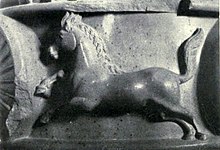
Various foreign influences have been described in the design of these capitals.
The
- Chronological order
Based on stylistic and technical analysis, it is possible to establish a tentative chronological orders for the pillars. The earliest one seems to be the
Other chronological orders have also been proposed, for example based on the style of the Ashokan inscriptions on the pillars, since the stylistically most sophisticated pillars actually have the engravings of the
| Known capitals of the pillars of Ashoka Ordered chronologically based on stylistic and technical analysis.[51] |
|
Of the
A few more possibly Ashokan capitals were also found without their pillars:
- Lauriya Nandangarh pillar, except for the hind legs of the lion, which did not protrude beyond the abacus.[1]This capital is now lost.
- ).
It is also known from various ancient sculptures (reliefs from Bharhut, 100 BC), and later narrative account by Chinese pilgrims (5-6th century AD), that there was a pillar of Ashoka at the Mahabodhi Temple founded by Ashoka, that it was crowned by an elephant.[55]
The same Chinese pilgrims have reported that the capital of the Lumbini pillar was a horse (now lost), which, by their time had already fallen to the ground.[55]
Inscriptions
The inscriptions on the columns include a fairly standard text. The inscriptions on the columns join other, more numerous, Ashokan inscriptions on natural rock faces to form the body of texts known as the Edicts of Ashoka. These inscriptions were dispersed throughout the areas of modern-day Bangladesh, India, Nepal, Afghanistan and Pakistan and represent the first tangible evidence of Buddhism. The edicts describe in detail Ashoka's policy of Dhamma, an earnest attempt to solve some of problems that a complex society faced.[56] In these inscriptions, Ashoka refers to himself as "Beloved servant of the Gods" (Devanampiyadasi). The inscriptions revolve around a few recurring themes: Ashoka's conversion to Buddhism, the description of his efforts to spread Buddhism, his moral and religious precepts, and his social and animal welfare program. The edicts were based on Ashoka's ideas on administration and behaviour of people towards one another and religion.
Alexander Cunningham, one of the first to study the inscriptions on the pillars, remarks that they are written in eastern, middle and western Prakrits which he calls "the Punjabi or north-western dialect, the Ujjeni or middle dialect, and the Magadhi or eastern dialect."[57] They are written in the Brahmi script.
Minor Pillar Edicts
These contain inscriptions recording their dedication, as well as the Schism Edicts and the Queen's Edict. They were inscribed around the 13th year of Ashoka's reign.
- Sanchi pillar (Schism Edict)
- Sarnath pillar (Schism Edict)
- Allahabadpillar (Schism Edict, Queen Edict, and also Major Pillar Edicts)
- Lumbini (Rummindei), Nepal (the upper part broke off when struck by lightning; the original horse capital mentioned by Xuanzang is missing) was erected by Ashoka where Buddha was born.
- Nigali Sagar (or Nigliva), near Lumbini, Rupandehi district, Nepal (originally near the Buddha Konakarnana stupa)
-
Kosambi-Allahabad Schism Edict.
-
Sanchi Schism Edict.
-
Sarnath Schism Edit.
-
Rummindei, in Lumbini.
Major Pillar Edicts
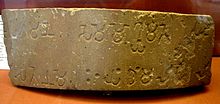
Asoka's 6 Major Pillar Edicts have been found at Kausambhi (Allahabad), Topra (now Delhi), Meerut (now Delhi), Lauriya-Araraj, Lauriya-Nandangarh, Rampurva (Champaran), and a 7th one on the Delhi-Topra pillar.
These pillar edicts include:[59]
- I Asoka's principle of protection to people
- II Defines dhamma as minimum of sins, many virtues, compassion, liberality, truthfulness and purity
- III Abolishes sins of harshness, cruelty, anger, pride etc.
- IV Deals with duties of government officials
- V List of animals and birds which should not be killed on some days and another list of animals which cannot be killed on any occasion. Describes release of 25 prisoners by Asoka.
- VI Works done by Asoka for Dhamma Policy. He says that all sects desire both self-control and purity of mind.
- VII Testimental edict.
-
Major Pillar Edicts I, II, III (Delhi-Topra)
-
Major Pillar Edicts IV (Delhi-Topra)
-
Major Pillar Edicts V-VII (Delhi-Topra)
-
Major Pillar Edicts VII, second part (Delhi-Topra)
Description of the pillars

Pillars retaining their animals
The most celebrated capital is the four-lion one at
The lions probably originally supported a
The pillar at Sanchi also has a similar but damaged four-lion capital. There are two pillars at Rampurva, one crowned with a bull and the other with a lion. Sankissa has only a damaged elephant capital, which is mainly unpolished, though the abacus is at least partly so. No pillar shaft has been found, and perhaps this was never erected at the site.[61]
The Vaishali pillar has a single lion capital.[62] The location of this pillar is contiguous to the site where a Buddhist monastery and a sacred coronation tank stood. Several stupas suggesting a far-flung campus for the monastery have been discovered. The lion faces north, the direction Buddha took on his last voyage.[63] Identification of the site for excavation in 1969 was aided by the fact that this pillar still jutted out of the soil. More such pillars exist in this greater area but they are all devoid of the capital.
Pillar at Prayagraj
In
The pillar is now located inside the
is supposed to have prayed while on exile.Pillars at Lauriya-Areraj and Lauriya-Nandangarh
The column at
Erecting the Pillars
The Pillars of Ashoka may have been erected using the same methods that were used to erect the ancient
Rediscoveries
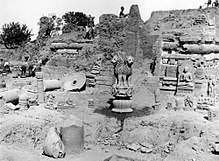
A number of the pillars were thrown down by either natural causes or iconoclasts, and gradually rediscovered. One was noticed in the 16th century by the English traveller Thomas Coryat in the ruins of Old Delhi. Initially he assumed that from the way it glowed that it was made of brass, but on closer examination he realized it was made of highly polished sandstone with upright script that resembled a form of Greek. In the 1830s James Prinsep began to decipher them with the help of Captain Edward Smith and George Turnour. They determined that the script referred to King Piyadasi which was also the epithet of an Indian ruler known as Ashoka who came to the throne 218 years after Buddha's enlightenment. Scholars have since found 150 of Ashoka's inscriptions, carved into the face of rocks or on stone pillars marking out a domain that stretched across northern India and south below the central plateau of the Deccan. These pillars were placed in strategic sites near border cities and trade routes.
The
Other Ashokan structures
- Stupas
According to legend, Ashoka built 84,000 stupas commemorating the events and relics of Buddha's life. Some of these stupas contained networks of walls containing the hub, spokes and rim of a wheel, while others contained interior walls in a swastika (卐) shape. The wheel represents the sun, time, and Buddhist law (the wheel of law, or dharmachakra), while the swastika stands for the cosmic dance around a fixed centre and guards against evil.[15][16]
- "Diamond throne" in Bodh Gaya
Ashoka also built the
The sculpted decorations on the Diamond Throne clearly echo the decorations found on the Pillars of Ashoka.
Similar pillars
The 6th-century pillar at the tomb of Xiao Jing, or
See also
Related topics
- Ashoka's Major Rock Edicts
- Dhar iron pillar
- Iron pillar of Delhi
- List of Edicts of Ashoka
- Stambha
Other similar topics
Notes
- ^ a b c d e f g h i j k l m n Buddhist Architecture, Huu Phuoc Le, Grafikol, 2010 p.36-40
- OCLC 299661763.
- ^ a b Inscriptions of Asoka. New Edition by E. Hultzsch (in Sanskrit). 1925. p. 132, Edict No 7 line 23.
- ISBN 9780860133209.
- ^ ISBN 9781317560067.
- ^ India: The Ancient Past: A History of the Indian Subcontinent from c. 7000 BCE to CE 1200, Burjor Avari Routledge, 2016 p.139
- ^ a b Krishnaswamy, 697-698
- ^ "KING ASHOKA: His Edicts and His Times". www.cs.colostate.edu. Retrieved 29 October 2017.
- ^ India: The Ancient Past: A History of the Indian Subcontinent from c. 7000 BCE to CE 1200, Burjor Avari, Routledge, 2016 p.149
- ^ State Emblem, Know India india.gov.in
- ^ Companion, 430
- ^ "Lion Capital of Ashoka At Sarnath Archaeological Museum Near Varanasi India". YouTube.
- ^ Agrawala, Vasudeva Sharana (1965). Studies In Indian Art. p. 67.
- ^ "Remains of the topmost wheel in the Sarnath Archaeological Museum". 17 February 2019.
- ^ a b Time Life Lost Civilizations series: Ancient India: Land Of Mystery (1994) p. 84-85,94-97
- ^ a b Oliphant, Margaret "The Atlas Of The Ancient World" 1992 p. 156-7
- ^ ISBN 978-81-85205-53-3.
It can also be suggested that Lāțs topped by animal figures also have an ancestor in the sphinx - topped pillars of Greece of the Middle Archaic period (c.580-40 B.C), Delphi Museum at Delphi, Greece, has an elegant winged sphinx figure sitting on an Ionic capital with side volutes. It was the Naxian sphinx pillar datable to about 575-560 BC. Many more sphinx-pillars have been found from different parts of Greece like Sparta, Athens and Spata (Attica). Rowland traces western Asiatic inspirations in the addorsed animal capitals of Aśokas Lāțs. But the inspiration for the single animal figure Lāțs, should be traced in the sphinx pillars of Greece. Asoka's direct link with his contemporaneous Greek states of Western Asia , Africa and Greece itself can result in the conception of single animal topped Lățs , from the Delphi type sphinx pillars. Such a possibility should not be ruled out in Mauryan Age.
- JSTOR 877843.
- ^ Harle, 22
- ISBN 0-19-564445-X, pp.267-70
- ^ ISBN 81-219-0887-6, pp.350-3
- ^ Companion,
- ^ a b Buddhist Architecture, by Huu Phuoc Le, Grafikol, 2010 p.44
- ^ Rebecca M. Brown, Deborah S. Hutton. A Companion to Asian Art and Architecture. John Wiley & Sons. pp. 423–429.
- ^ a b Boardman (1998), 15
- ^ Boardman (1998), 13
- ^ Harle, 22, 24, quoted in turn
- ^ A Comprehensive History Of Ancient India, Sterling Publishers Pvt. Ltd, 2003, p.87
- ^ Stewart, Desmond. Pyramids and the Sphinx. [S.l.]: Newsweek, U.S., 72. Print.
- JSTOR 877843.
- ^ Agrawala, Vasudeva S. (1977). Gupta Art Vol.ii.
- S2CID 162953368.
- ^ Boardman (1998), 13-19
- ISBN 9788131711200. Retrieved 10 April 2018.
- ^ The Early History of India by Vincent A. Smith
- ^ Annual report 1906-07 p.89
- ^ Ashoka, 2
- ISBN 978-81-317-1677-9.
- ^ Buddhist Architecture, Le Huu Phuoc, Grafikol 2009, p.169
- ^ Sircar, D. C. (1979). Asokan studies. pp. 118–122.
- ^ Sircar, D. C. (1979). Asokan studies. p. 118.
- ^ Mapio
- ^ Asoka by Radhakumud Mookerji p.85
- ^ a b Buddhist Architecture, Le Huu Phuoc, Grafikol 2009, p.40
- ISBN 9780295742380.
- ^ A Brief History of India, Alain Daniélou, Inner Traditions / Bear & Co, 2003, p.89-91 [1]
- ^ The pillars "owe something to the pervasive influence of Achaemenid architecture and sculpture, with no little Greek architectural ornament and sculptural style as well. Notice the florals on the bull capital from Rampurva, and the style of the horse of the Sarnath capital, now the emblem of the Republic of India." "The Diffusion of Classical Art in Antiquity" by John Boardman, Princeton University Press, 1993, p.110
- ISBN 9780984404308. Retrieved 29 October 2017 – via Google Books.
- ISBN 9780984404308. Retrieved 29 October 2017 – via Google Books.
- ^ a b Buddhist Architecture, Huu Phuoc Le, Grafikol, 2010 p.240
- ^ a b Le Huu Phuoc, Buddhist Architecture, p.42
- ^ a b c The True Chronology of Aśokan Pillars, John Irwin, Artibus Asiae, Vol. 44, No. 4 (1983), pp. 247-265 [2]
- ^ Story of the Delhi Iron Pillar, R. Balasubramaniam p.19
- ^ The Past Before Us, Romila Thapar p.361
- ^ a b Buddhist Architecture, Le Huu Phuoc, Grafikol 2009, pp 238-248
- ^ "The Ashokan rock edicts are a marvel of history".
- ^ Inscriptions of Ashoka by Alexander Cunningham, Eugen Hultzsch. Calcutta: Office of the Superintendent of Government Printing. Calcutta: 1877
- ^ "British Museum Highlights". Retrieved 29 October 2017.
- ^ Full texts, An English rendering by Ven. S. Dhammika, 1993
- ^ "Wat Umong Chiang Mai". Thailand's World. Archived from the original on 3 December 2013. Retrieved 26 November 2013.
- ^ Companion, 428-429
- ^ "Destinations :: Vaishali". Archived from the original on 22 July 2015. Retrieved 25 December 2006.
- ^ "Destinations :: Vaishali ::Bihar State Tourism Development Corporation". bstdc.bih.nic.in. Archived from the original on 22 July 2015. Retrieved 29 October 2017.
- ^ Krishnaswamy, 697-700
- ^ "NOVA Online - Mysteries of the Nile - August 27, 1999: The Third Attempt". www.pbs.org. Retrieved 29 October 2017.
- ^ Time Life Lost Civilizations series: Ramses II: Magnificence on the Nile (1993)p. 56-57
- ^ Allen, Chapter 15
- ^ A Global History of Architecture, Francis D. K. Ching, Mark M. Jarzombek, Vikramaditya Prakash, John Wiley & Sons, 2017 p.570ff
- ^ a b Buddhist Architecture, Huu Phuoc Le p.240
- ^ a b Alexander Cunningham, Mahâbodhi, or the great Buddhist temple under the Bodhi tree at Buddha-Gaya p.19 Public Domain text
- ISBN 9781408703885.
- ^ Mahâbodhi, Cunningham p.4ff Public Domain text
- ^ Buddhist Architecture by Huu Phuoc Le p.45
References
- Ashoka, Emperor, Edicts of Ashoka, eds. N. A. Nikam, Richard P. McKeon, 1978, University of Chicago Press, ISBN 0226586111, 9780226586113, google books
- Boardman, John (1998), "Reflections on the Origins of Indian Stone Architecture", Bulletin of the Asia Institute, pp. 15–19, 1998, New Series, Vol. 12, (Alexander's Legacy in the East: Studies in Honor of Paul Bernard), p. 13-22, JSTOR
- "Companion": Brown, Rebecca M., Hutton, Deborah S., eds., A Companion to Asian Art and Architecture, Volume 3 of Blackwell companions to art history, 2011, John Wiley & Sons, 2011, ISBN 1444396323, 9781444396324, google books
- Harle, J.C., The Art and Architecture of the Indian Subcontinent, 2nd edn. 1994, Yale University Press Pelican History of Art, ISBN 0300062176
- Krishnaswamy, C.S., Sahib, Rao, and Ghosh, Amalananda, "A Note on the Allahabad Pillar of Aśoka", The Journal of the Royal Asiatic Society of Great Britain and Ireland, No. 4 (Oct., 1935), pp. 697–706, Royal Asiatic Society of Great Britain and Ireland, JSTOR
- Falk, H. Asokan Sites and Artefacts: a A Source-book with Bibliography, 2006, Volume 18 of Monographien zur indischen Archäologie, Kunst und Philologie, Von Zabern, ISSN 0170-8864
Further reading
- Singh, Upinder (2008). "Chapter 7: Power and Piety: The Maurya Empire, c. 324-187 BCE". A History of Ancient and Early Medieval India: From the Stone Age to the 12th Century. New Delhi: Pearson Education. ISBN 978-81-317-1677-9.
External links
- Archaeological Survey of India
- British Museum, collections online
- Columbia University, New York - See "lioncapital" for pictures of the original "Lion Capital of Ashoka" preserved at the Sarnath Museum which has been adopted as the "National Emblem of India" and the Ashoka Chakra (Wheel) from which has been placed in the centre of the "National Flag of India".









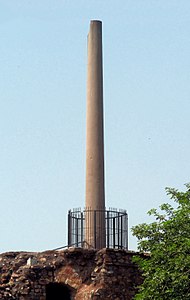






![Fragment of pillar with inscription, Amaravati.[41]](http://upload.wikimedia.org/wikipedia/commons/thumb/d/df/Amaravati_Major_Pillar_Edict_inscription.jpg/137px-Amaravati_Major_Pillar_Edict_inscription.jpg)

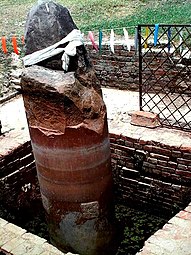
![Bodh Gaya (originally near Sujata Stupa, brought from Gaya in 1956).[45]](http://upload.wikimedia.org/wikipedia/commons/thumb/0/0b/Ashoka_pillar_Bodh_Gaya.jpg/191px-Ashoka_pillar_Bodh_Gaya.jpg)



